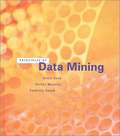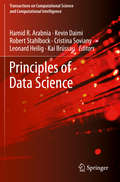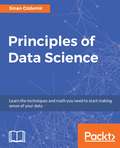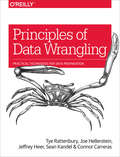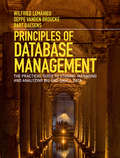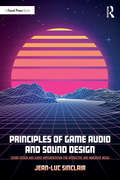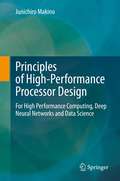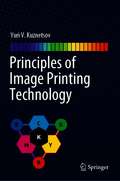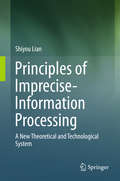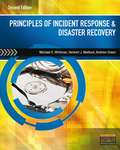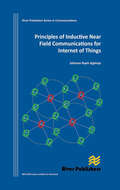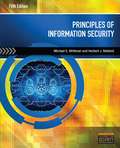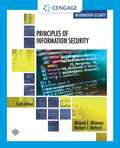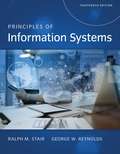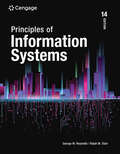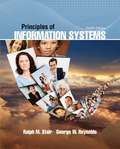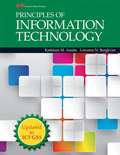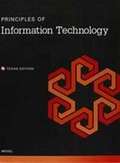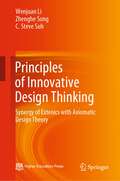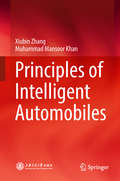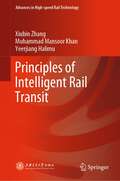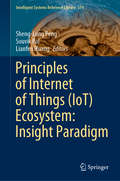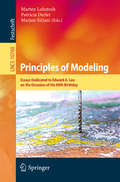- Table View
- List View
Principles of Data Mining
by David J. Hand Heikki Mannila Padhraic SmythThe growing interest in data mining is motivated by a common problem across disciplines: how does one store, access, model, and ultimately describe and understand very large data sets? Historically, different aspects of data mining have been addressed independently by different disciplines. This is the first truly interdisciplinary text on data mining, blending the contributions of information science, computer science, and statistics. The book consists of three sections. The first, foundations, provides a tutorial overview of the principles underlying data mining algorithms and their application. The presentation emphasizes intuition rather than rigor. The second section, data mining algorithms, shows how algorithms are constructed to solve specific problems in a principled manner. The algorithms covered include trees and rules for classification and regression, association rules, belief networks, classical statistical models, nonlinear models such as neural networks, and local "memory-based" models. The third section shows how all of the preceding analysis fits together when applied to real-world data mining problems. Topics include the role of metadata, how to handle missing data, and data preprocessing.
Principles of Data Science (Transactions on Computational Science and Computational Intelligence)
by Hamid R. Arabnia Robert Stahlbock Kevin Daimi Cristina Soviany Leonard Heilig Kai BrüssauThis book provides readers with a thorough understanding of various research areas within the field of data science. The book introduces readers to various techniques for data acquisition, extraction, and cleaning, data summarizing and modeling, data analysis and communication techniques, data science tools, deep learning, and various data science applications. Researchers can extract and conclude various future ideas and topics that could result in potential publications or thesis. Furthermore, this book contributes to Data Scientists’ preparation and to enhancing their knowledge of the field. The book provides a rich collection of manuscripts in highly regarded data science topics, edited by professors with long experience in the field of data science.Introduces various techniques, methods, and algorithms adopted by Data Science expertsProvides a detailed explanation of data science perceptions, reinforced by practical examplesPresents a road map of future trends suitable for innovative data science research and practice
Principles of Data Science
by Sinan OzdemirLearn the techniques and math you need to start making sense of your data About This Book • Enhance your knowledge of coding with data science theory for practical insight into data science and analysis • More than just a math class, learn how to perform real-world data science tasks with R and Python • Create actionable insights and transform raw data into tangible value Who This Book Is For You should be fairly well acquainted with basic algebra and should feel comfortable reading snippets of R/Python as well as pseudo code. You should have the urge to learn and apply the techniques put forth in this book on either your own data sets or those provided to you. If you have the basic math skills but want to apply them in data science or you have good programming skills but lack math, then this book is for you. What You Will Learn • Get to know the five most important steps of data science • Use your data intelligently and learn how to handle it with care • Bridge the gap between mathematics and programming • Learn about probability, calculus, and how to use statistical models to control and clean your data and drive actionable results • Build and evaluate baseline machine learning models • Explore the most effective metrics to determine the success of your machine learning models • Create data visualizations that communicate actionable insights • Read and apply machine learning concepts to your problems and make actual predictions In Detail Need to turn your skills at programming into effective data science skills? Principles of Data Science is created to help you join the dots between mathematics, programming, and business analysis. With this book, you'll feel confident about asking—and answering—complex and sophisticated questions of your data to move from abstract and raw statistics to actionable ideas. With a unique approach that bridges the gap between mathematics and computer science, this books takes you through the entire data science pipeline. Beginning with cleaning and preparing data, and effective data mining strategies and techniques, you'll move on to build a comprehensive picture of how every piece of the data science puzzle fits together. Learn the fundamentals of computational mathematics and statistics, as well as some pseudocode being used today by data scientists and analysts. You'll get to grips with machine learning, discover the statistical models that help you take control and navigate even the densest datasets, and find out how to create powerful visualizations that communicate what your data means. Style and approach This is an easy-to-understand and accessible tutorial. It is a step-by-step guide with use cases, examples, and illustrations to get you well-versed with the concepts of data science. Along with explaining the fundamentals, the book will also introduce you to slightly advanced concepts later on and will help you implement these techniques in the real world.
Principles of Data Wrangling: Practical Techniques for Data Preparation
by Connor Carreras Jeffrey Heer Joseph M. Hellerstein Sean Kandel Tye RattenburyA key task that any aspiring data-driven organization needs to learn is data wrangling, the process of converting raw data into something truly useful. This practical guide provides business analysts with an overview of various data wrangling techniques and tools, and puts the practice of data wrangling into context by asking, "What are you trying to do and why?". Wrangling data consumes roughly 50-80% of an analyst’s time before any kind of analysis is possible. Written by key executives at Trifacta, this book walks you through the wrangling process by exploring several factors—time, granularity, scope, and structure—that you need to consider as you begin to work with data. You’ll learn a shared language and a comprehensive understanding of data wrangling, with an emphasis on recent agile analytic processes used by many of today’s data-driven organizations.Appreciate the importance—and the satisfaction—of wrangling data the right way. Understand what kind of data is available. Choose which data to use and at what level of detail. Meaningfully combine multiple sources of data. Decide how to distill the results to a size and shape that can drive downstream analysis.
Principles of Database Management: The Practical Guide to Storing, Managing and Analyzing Big and Small Data
by Wilfried Lemahieu Seppe Vanden Broucke Bart BaesensThis comprehensive textbook teaches the fundamentals of database design, modeling, systems, data storage, and the evolving world of data warehousing, governance and more. Written by experienced educators and experts in big data, analytics, data quality, and data integration, it provides an up-to-date approach to database management. This full-color, illustrated text has a balanced theory-practice focus, covering essential topics, from established database technologies to recent trends, like Big Data, NoSQL, and more. Fundamental concepts are supported by real-world examples, query and code walkthroughs, and figures, making it perfect for introductory courses for advanced undergraduates and graduate students in information systems or computer science. These examples are further supported by an online playground with multiple learning environments, including MySQL; MongoDB; Neo4j Cypher; and tree structure visualization. This combined learning approach connects key concepts throughout the text to the important, practical tools to get started in database management.
Principles Of Digital Communication: A Top-Down Approach
by Bixio RimoldiThis comprehensive and accessible text teaches the fundamentals of digital communication via a top-down-reversed approach, specifically formulated for a one-semester course. The unique approach focuses on the transmission problem and develops knowledge of receivers before transmitters. In doing so it cuts straight to the heart of the digital communication problem, enabling students to learn quickly, intuitively, and with minimal background knowledge. Beginning with the decision problem faced by a decoder and going on to cover receiver designs for different channels, hardware constraints, design trade-offs, convolutional coding, Viterbi decoding, and passband communication, detail is given on system-level design as well as practical applications in engineering. All of this is supported by numerous worked examples, homework problems, and MATLAB simulation exercises to aid self-study, providing a solid basis for students to specialize in the field of digital communication and making it suitable for both traditional and flipped classroom teaching.
Principles of Digital Communication and Coding (Dover Books on Electrical Engineering)
by Jim K. Omura Andrew J. ViterbiWritten by two distinguished experts in the field of digital communications, this classic text remains a vital resource three decades after its initial publication. Its treatment is geared toward advanced students of communications theory and to designers of channels, links, terminals, modems, or networks used to transmit and receive digital messages.The three-part approach begins with the fundamentals of digital communication and block coding, including an analysis of block code ensemble performance. The second part introduces convolutional coding, exploring ensemble performance and sequential decoding. The final section addresses source coding and rate distortion theory, examining fundamental concepts for memoryless sources as well as precepts related to memory, Gaussian sources, and universal coding. Appendixes of useful information appear throughout the text, and each chapter concludes with a set of problems, the solutions to which are available online.
Principles of Game Audio and Sound Design: Sound Design and Audio Implementation for Interactive and Immersive Media
by Jean-Luc SinclairPrinciples of Game Audio and Sound Design is a comprehensive introduction to the art of sound for games and interactive media using Unity. This accessible guide encompasses both the conceptual challenges of the artform as well as the technical and creative aspects, such as sound design, spatial audio, scripting, implementation and mixing. Beginning with basic techniques, including linear and interactive sound design, before moving on to advanced techniques, such as procedural audio, Principles of Game Audio and Sound Design is supplemented by a host of digital resources, including a library of ready-to-use, adaptable scripts. This thorough introduction provides the reader with the skills and tools to combat the potential challenges of game audio independently. Principles of Game Audio and Sound Design is the perfect primer for beginner- to intermediate-level readers with a basic understanding of audio production and Unity who want to learn how to gain a foothold in the exciting world of game and interactive audio.
Principles of High-Performance Processor Design: For High Performance Computing, Deep Neural Networks and Data Science
by Junichiro MakinoThis book describes how we can design and make efficient processors for high-performance computing, AI, and data science. Although there are many textbooks on the design of processors we do not have a widely accepted definition of the efficiency of a general-purpose computer architecture. Without a definition of the efficiency, it is difficult to make scientific approach to the processor design. In this book, a clear definition of efficiency is given and thus a scientific approach for processor design is made possible. In chapter 2, the history of the development of high-performance processor is overviewed, to discuss what quantity we can use to measure the efficiency of these processors. The proposed quantity is the ratio between the minimum possible energy consumption and the actual energy consumption for a given application using a given semiconductor technology. In chapter 3, whether or not this quantity can be used in practice is discussed, for many real-world applications. In chapter 4, general-purpose processors in the past and present are discussed from this viewpoint. In chapter 5, how we can actually design processors with near-optimal efficiencies is described, and in chapter 6 how we can program such processors. This book gives a new way to look at the field of the design of high-performance processors.
Principles of Image Printing Technology
by Yuri V. KuznetsovPrinciples of Image Printing Technology is a unique review of technology use in the printing industry since the time of the medieval engravers and busy newsroom typesetters. It provides a historical review of the advancement of technology and describes in-depth both technical fundamentals and industrial procedures. Intended primarily for students in graphic communications programs, this book includes all the necessary background for understanding printing technology. In addition, by providing findings from basic research studies and industrial processes that have been omitted elsewhere in published volumes, it offers a useful guide to researchers and professionals in the printing industry.
Principles of Imprecise-Information Processing
by Shiyou LianThe book showcases cutting-edge concepts and methods, and presents the principle of imprecise-information processing. It also proposes a new theory and technology for imprecise-information processing that differs from fuzzy technology, thus providing a platform for related applications and laying the theoretical basis for further research. Imprecise-information processing - a type of processing based on flexible linguistic values and quantifiable rigid linguistic values - is an important component of intelligence science and technology. This book offers an easy-to-understand overview of the basic principles and methods of imprecise-information processing, allowing readers to develop related applications or pursue further research.
Principles Of Incident Response And Disaster Recovery
by Michael Whitman Herbert Mattord Andrew GreenPrinciples Of Incident Response And Disaster Recovery, 2nd Edition presents methods to identify vulnerabilities within computer networks and the countermeasures that mitigate risks and damage. From market-leading content on contingency planning, to effective techniques that minimize downtime in an emergency, to curbing losses after a breach, this text is the resource needed in case of a network intrusion.
Principles of Inductive Near Field Communications for Internet of Things
by Johnson I. AgbinyaNear field communication devices and the emerging field of Internet of things require efficient short range communication techniques. Classical telecommunication theory however has so far focused on radiating electromagnetic signals which is more suited to terrestrial communication systems. Over the last decade however considerable research and applications of inductive methods have emerged as innovative approaches for secure short range communications by changing the paradigm of an established model of electromagnetic communications. We have witnessed the emergence of embedded inductive medical devices, magneto-inductive waveguides, inductive pots and cooking devices, magneto-inductive sensors, wireless power transfer, inductive hearing aids and the emerging inductive point-to-point communication specifically termed near-field communication (NFC) as used in mobile phones and payment cards to name a few. While there exist a large set of distributed methods and algorithms detailing the design and performances of such applications, a significant gap is observed as a lack of detailed collection of the methods in one place which could be easily understood and used quickly by someone seeking to apply the methods.In this book this missing gap is filled with the required details and the theory of near field communication systems including both the radiating and reactive (energy coupling) near-field systems in addition to the well known far field radiation techniques. The book details the fundamental expressions and design methods which facilitate the creation of near field devices and equipment including embedded biomedical implants. The book contains recent advances in inductive communications, performance, limitations and a collection of applications. It also lays a strong foundation for the application of inductive methods for creating Internet of Things systems.
Principles of Information Security
by Michael E. Whitman Herbert J. MattordSpecifically oriented to the needs of information systems students, PRINCIPLES OF INFORMATION SECURITY, 5e delivers the latest technology and developments from the field. Taking a managerial approach, this bestseller teaches all the aspects of information security-not just the technical control perspective. It provides a broad review of the entire field of information security, background on many related elements, and enough detail to facilitate understanding of the topic. It covers the terminology of the field, the history of the discipline, and an overview of how to manage an information security program. Current and relevant, the fifth edition includes the latest practices, fresh examples, updated material on technical security controls, emerging legislative issues, new coverage of digital forensics, and hands-on application of ethical issues in IS security. It is the ultimate resource for future business decision-makers.
Principles of Information Security (MindTap Course List Series)
by Michael E. Whitman Herbert J. MattordPrinciples of Information Security, Sixth Edition, provides a broad review of the entire field of information security, background on many related elements, and enough detail to facilitate an understanding of the topic as a whole. The book covers the terminology of the field, the history of the discipline, and strategies for managing an information security program. You review terms used in the field and a history of the discipline as you learn how to manage an information security program. Current and relevant, this edition highlights the latest practices with fresh examples that explore the impact of emerging technologies, such as the Internet of Things, Cloud Computing, and DevOps. Updates address technical security controls, emerging legislative issues, digital forensics, and ethical issues in IS security, making this the ideal IS resource for business decision makers.
Principles Of Information Systems
by Ralph M. Stair George W. ReynoldsDevelop an understanding of the core principles of IS and how it is practiced today with PRINCIPLES OF INFORMATION SYSTEMS, 13th edition. This edition combines the latest research with the most current coverage available as content highlights IS-related careers. You explore the challenges and risks of computer crimes, hacking, and cyberterrorism as well as the most current research on big data, analytics, and global IS and social networking. In addition, you examine business intelligence, cloud computing, e-commerce, enterprise systems, mobile computing, strategic planning, and systems acquisition. You learn how information systems can increase profits and reduce costs as you explore artificial intelligence, change management, data governance, environmental concerns, Internet of Everything, Internet censorship and net neutrality, virtual teams, and more. Interactive multimedia resources, MindTap, help you maximize success as an employee, decision maker, and business leader.
Principles of Information Systems
by Ralph M. Stair George W. Reynolds Joey Bryant Mark Frydenberg Hollis Greenberg George SchellDevelop an understanding of the core principles of information systems (IS) and how these principles make a difference in today's business environment with Stair/Reynolds' PRINCIPLES OF INFORMATION SYSTEMS, 14E. Completely reorganized for clarity and focus, this fresh new edition provides engaging new chapter opening cases and a new chapter on AI and automation. You explore the challenges and risks of cybercrime, hacking, internet of things, and artificial intelligence as you examine the latest IS research and learn from memorable examples. You can even maximize your employability as you learn how to use IS to increase profits and reduce costs in organizations. You study the latest in big data, business intelligence, cloud computing, e-commerce, enterprise systems, mobile computing, strategic planning, and systems development.
Principles of Information Systems (Twelfth Edition)
by Ralph Stair George ReynoldsEquipping you with a solid understanding of the core principles of IS and how it is practiced, PRINCIPLES OF INFORMATION SYSTEMS, 12E covers the latest research and developments from the field and their impact on the rapidly changing role of today's IS professional. The book includes expansive coverage of mobile solutions, energy and environmental concerns, cloud computing, IS careers, virtual communities, global IS work solutions, and social networking. You learn firsthand how information systems can increase profits and reduce costs as you explore new information on e-commerce and enterprise systems, artificial intelligence, virtual reality, green computing, and other issues reshaping the industry. The book also introduces the challenges and risks of computer crimes, hacking, and cyberterrorism. A long-running example illustrates how technology was used in the design, development, and production of this book. No matter where your career path may lead, PRINCIPLES OF INFORMATION SYSTEMS, 12E can help you maximize your success as an employee, a decision maker, and a business leader.
Principles of Information Technology
by Kathleen M. Austin Lorraine N. BergkvistPrinciples of Information Technology presents basic principles and concepts about information technology to help students become more valuable employees, better citizens, and knowledgeable consumers. Written specifically for high school students, this text maps to the IC3 Digital Literacy Certification standards. By studying this text, students can prepare for taking the Certiport IC3 Digital Literacy Certification exams. IC3 Digital Literacy Certification is a well-respected and internationally recognized credential.
Principles of Information Technology: Preparing for IC3 Certification
by Suzanne WeixelNIMAC-sourced textbook
Principles of Innovative Design Thinking: Synergy of Extenics with Axiomatic Design Theory
by Wenjuan Li Zhenghe Song C. Steve SuhThe book presents a comprehensive treatment on a novel design theory that fosters innovative thinking and creativity essential for addressing wicked problems. Wicked problems are ill-defined, ambiguous in both aims and solutions, and complex with interconnected and intertwined (coupled) factors. While being ubiquitous and difficult, however, wicked problems share characteristics common to science and design in three regards, namely agent finitude, system complexity, and problem normativity. These fundamental attributes allow a core cognitive process common to design and science to be identified and a strategic problem-solving conception of methodology be formulated as a result. The theory facilitates new opportunities for synergetic cross-disciplinary research and practice by incorporating the essences of Extenics to axiomatic design. Innovative thinking is enabled by exploring Extenics for problem reframing, paradigm shift, and abductive reasoning and by engaging axiomatic design in the co-evolution (iteration) of the need and viable design concept. The theory is unique in that it is a framework for quantifying imprecise and vague design information available during the conceptual design stage as mathematical expression and algorithm early in the design effort and enables the objective evaluation and emergence of an optimal design concept from among multitude of viable ones. The book is conceived for students and real-world practitioners in engineering, natural and social sciences, business, and fine arts who seek to develop powerful design thinking for solving problems in a creative and innovative way.
Principles of Intelligent Automobiles
by Muhammad Mansoor Khan Xiubin ZhangThis book discusses the principle of automotive intelligent technology from the point of view of modern sensing and intelligent control. Based on the latest research in the field, it explores safe driving with intelligent vision; intelligent monitoring of dangerous driving; intelligent detection of automobile power and transmission systems; intelligent vehicle navigation and transportation systems; and vehicle-assisted intelligent technology. It draws on the author’s research in the field of automotive intelligent technology to explain the fundamentals of vehicle intelligent technology, from the information sensing principle to mathematical models and the algorithm basis, enabling readers to grasp the concepts of automotive intelligent technology. Opening up new scientific horizons and fostering innovative thinking, the book is a valuable resource for researchers as well as undergraduate and graduate students.
Principles of Intelligent Rail Transit (Advances in High-speed Rail Technology)
by Xiubin Zhang Muhammad Mansoor Khan Yeerjiang HalimuThis book systematically expounds on the scientific principles and technologies of Rail Transit Intelligent Technology based on the high development of artificial intelligence theory and technology. The contents include technical principles, theoretical algorithms and practical engineering technologies of intelligent monitoring of rail transit system, intelligent sensing and identification of train power system, intelligent technology in rail transit system operation, intelligent maintenance of carriage environment, etc. It can be used as a textbook or teaching reference book for related fields in universities, including rail transit system, communication, automation, intelligent equipment design and manufacturing, artificial intelligence, computer science and technology, electrical engineering and automation, etc. It is used as an academic reference for professionals in rail transit system design, operation, and maintenance.
Principles of Internet of Things (Intelligent Systems Reference Library #174)
by Sheng-Lung Peng Souvik Pal Lianfen HuangThis book discusses the evolution of future-generation technologies through the Internet of things, bringing together all the related technologies on a single platform to offer valuable insights for undergraduate and postgraduate students, researchers, academics and industry practitioners. The book uses data, network engineering and intelligent decision- support system-by-design principles to design a reliable IoT-enabled ecosystem and to implement cyber-physical pervasive infrastructure solutions. It takes readers on a journey that begins with understanding the insight paradigm of IoT-enabled technologies and how it can be applied. It walks readers through engaging with real-time challenges and building a safe infrastructure for IoT-based, future-generation technologies. The book helps researchers and practitioners to understand the design architecture through IoT and the state of the art in IoT countermeasures. It also highlights the differences between heterogeneous platforms in IoT-enabled infrastructure and traditional ad hoc or infrastructural networks, and provides a comprehensive discussion on functional frameworks for IoT, object identification, IoT domain model, RFID technology, wearable sensors, WBAN, IoT semantics, knowledge extraction, and security and privacy issues in IoT-based ecosystems. Written by leading international experts, it explores IoT-enabled insight paradigms, which are utilized for the future benefit of humans. It also includes references to numerous works. Divided into stand-alone chapters, this highly readable book is intended for specialists, researchers, graduate students, designers, experts, and engineers involved in research on healthcare-related issues.
Principles of Modeling: Essays Dedicated to Edward A. Lee on the Occasion of His 60th Birthday (Lecture Notes in Computer Science #10760)
by Marten Lohstroh Patricia Derler Marjan SirjaniThis Festschrift is published in honor of Edward A. Lee, Robert S. Pepper Distinguished Professor Emeritus and Professor in the Graduate School in the Department of Electrical Engineering and Computer Sciences at the University of California, Berkeley, USA, on the occasion of his 60th birthday.The title of this Festschrift is “Principles of Modeling" because Edward A. Lee has long been devoted to research that centers on the role of models in science and engineering. He has been examining the use and limitations of models, their formal properties, their role in cognition and interplay with creativity, and their ability to represent reality and physics. The Festschrift contains 29 papers that feature the broad range of Edward A. Lee’s research topics; such as embedded systems; real-time computing; computer architecture; modeling and simulation, and systems design.
